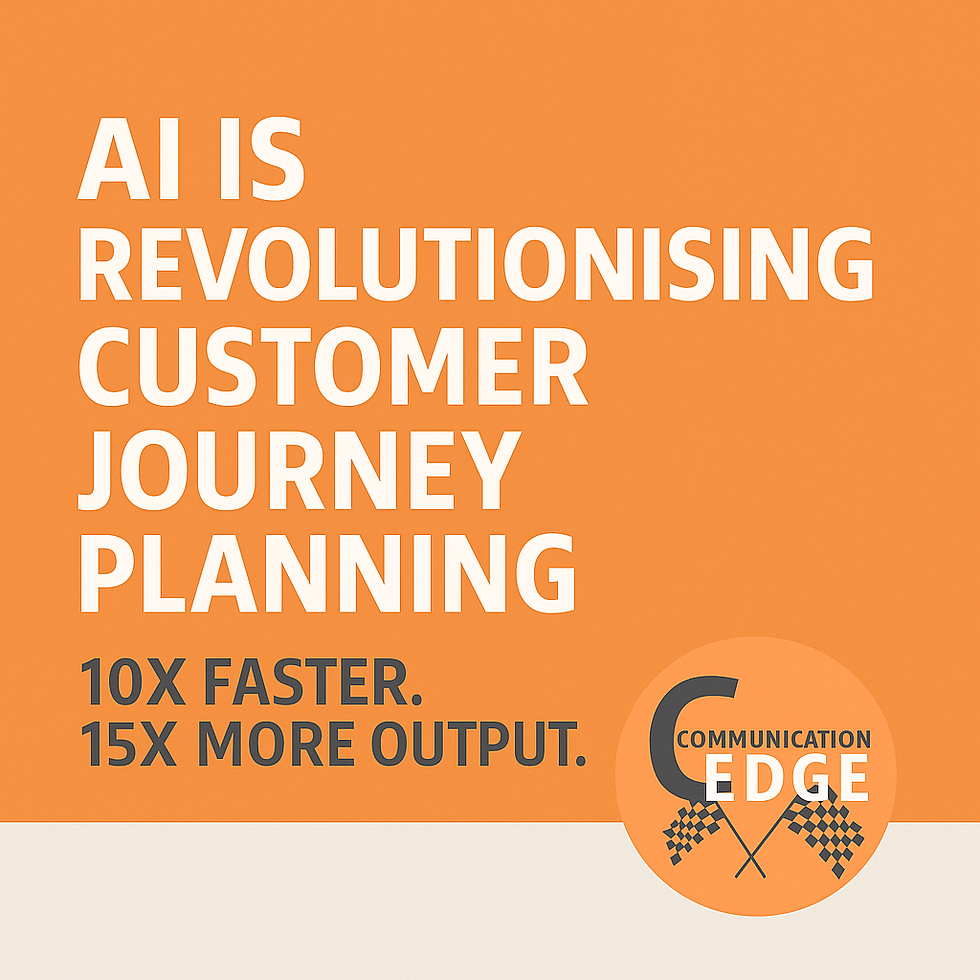How AI Has Transformed Lead Generation for SMEs With AI Marketing Speed
- Simon Hunt
- Sep 9
- 6 min read
Updated: Oct 21
In the last decade, marketing has gone through more change than in the previous fifty years combined. At the heart of this transformation is Artificial Intelligence (AI). Once considered futuristic, AI has now become mainstream, reshaping how businesses — particularly SMEs — find, attract, and convert customers.
For Managing Directors and CEOs, lead generation has always been a top priority. But in an environment where budgets are tight, competition is fierce, and expectations for ROI are higher than ever, AI is rewriting the playbook.
This blog explores how lead generation has changed with AI, the tools driving this change, and how businesses can use them to grow smarter.

1. From Guesswork to Data-Driven Precision and AI Marketing Speed
Traditional lead generation relied on broad tactics: networking events, cold calling, email blasts, or expensive ad campaigns. The problem? A lot of wasted time and budget chasing poor-quality leads.
AI has eliminated much of that guesswork. Algorithms can now analyze millions of data points — demographics, online behaviours, purchase intent signals, social engagement — to identify prospects that fit your Ideal Customer Profile (ICP).
Instead of building a wide funnel and hoping for results, AI lets you focus on the right accounts, the right decision-makers, at the right time.
Example: AI-powered platforms like LinkedIn Sales Navigator or ZoomInfo now integrate intent data, flagging when a company is actively researching solutions like yours. That means sales teams don’t waste months knocking on doors that will never open.
2. Hyper-Personalisation at Scale
Once upon a time, personalisation meant adding someone’s name to an email. Today, AI takes it much further. Tools like HubSpot, Drift, and Mutiny use AI to personalise website copy, email sequences, and even ad creatives based on a visitor’s industry, company size, or stage in the buyer journey.
For SMEs, this is game-changing. You no longer need a huge team of marketers to deliver bespoke experiences. AI tools automate it, making every touchpoint more relevant. And at the same time get the benefit of AI marketing speed.
The result: Higher engagement rates, stronger trust, and more qualified enquiries landing in your pipeline.
3. Smarter Content and SEO
Lead generation depends on visibility — and visibility depends on content. But writing blog after blog without a strategy is costly and ineffective.
AI now helps businesses identify what to write, who to write it for, and how to get it ranking in search. Tools like SurferSEO, Jasper, and SEMrush’s AI capabilities can:
Analyse competitor content and traffic.
Suggest topics with high search intent.
Optimise articles for keywords your prospects are actually searching.
For SMEs, this means your limited content budget goes further. Instead of publishing guesswork blogs, you produce high-performing content that directly fuels enquiry growth.
4. Predictive Lead Scoring
Every business has faced the frustration of leads that look promising but go nowhere. AI is solving this through predictive lead scoring.
By analysing historical deal data, AI assigns scores to new leads based on their likelihood to convert. Factors include:
Industry and company size.
Engagement with your website or emails.
Behavioural triggers (e.g., visiting pricing pages).
For sales teams, this creates a clear priority list. They can focus on leads with the highest chance of becoming customers, increasing conversion rates without increasing effort.
5. Conversational AI: Always-On Engagement
Chatbots used to be clunky and annoying. Not anymore. Conversational AI, powered by natural language processing (NLP), has matured into a powerful lead-gen tool.
Platforms like Drift, Intercom, and SimplyAI (speech-to-speech AI) can now:
Qualify visitors in real time.
Answer complex questions.
Book meetings directly into sales diaries.
For SMEs, this means your website is working 24/7 to capture and qualify leads, even when your team is offline.
6. Lower Cost of Acquisition
Historically, generating leads meant high spend — agencies charging retainers, pay-per-click ads with escalating costs, and endless trial-and-error campaigns.
AI lowers Customer Acquisition Costs (CAC) by:
Reducing waste on irrelevant clicks.
Improving conversion rates through personalisation.
Automating manual processes like reporting and follow-up.
The bottom line? More leads, at lower cost, with less reliance on expensive external agencies.
7. Real-Time Analytics and ROI Transparency
Marketing leaders have long struggled to prove ROI. AI changes that by providing real-time dashboards and predictive analytics.
With tools like GA4, Looker Studio, or Power BI (powered by AI connectors), you can see:
Which campaigns are generating enquiries.
Which channels deliver the best CAC:LTV ratio.
Forecasts for pipeline growth.
This level of transparency is vital for MDs and CFOs making budget decisions. You no longer have to rely on vanity metrics — AI shows the true commercial impact of marketing.
8. The Human + AI Hybrid
A common fear is that AI will replace marketers. The reality is different: AI is best seen as a co-pilot, not a replacement.
Humans bring strategy, creativity, and emotional intelligence. AI brings speed, data, and scalability. Together, they create a hybrid model that’s far more powerful than either alone.
For SMEs, this is liberating. You don’t need a 20-person marketing department. A fractional CMO supported by a lean internal team and AI tools can deliver enterprise-level growth.
9. Risks and Watchouts
Of course, AI isn’t a silver bullet. There are pitfalls:
Over-automation: Losing the human touch can damage trust.
Data privacy: AI must be compliant with UK GDPR, PECR, and ICO rules.
Tool overload: Too many disconnected AI tools can create chaos instead of clarity.
The answer? Use AI strategically. Start with the tools that give the biggest lift to lead generation (e.g., predictive scoring, chatbots, SEO intelligence) and build from there.
10. What This Means for SMEs
For small and mid-cap businesses, the impact of AI is clear:
Fewer wasted enquiries. AI filters out the noise and surfaces leads that matter.
Faster growth. Campaigns adapt in real time to what’s working.
Lower cost. Automation replaces expensive agency hours.
Scalable systems. SMEs can compete with larger rivals on capability without matching their budgets.
In short, AI levels the playing field.
Conclusion
Lead generation has evolved from scattergun tactics to a precision-driven, scalable, and ROI-focused discipline. AI sits at the heart of that change.
For SME leaders, the challenge is no longer whether to use AI in lead generation — it’s how quickly you can adopt it before your competitors pull ahead.
With the right strategy, tools, and leadership — often best delivered through a Fractional CMO model — AI-driven lead generation can transform enquiry flow, cut costs, and fuel sustainable growth.
Top 10 FAQs: Acquire AI – Marketing at Speed
What does “Acquire AI” mean in a marketing context?
Acquire AI refers to using artificial intelligence to accelerate how businesses plan, create, and optimise marketing — helping them capture customers faster with data-driven decisions.
How does AI increase marketing speed?
AI automates manual processes like content production, campaign optimisation, and data analysis, reducing workflows that once took days to just minutes.
Can AI help small and mid-sized businesses compete with larger firms?
Yes. AI gives SMEs enterprise-level tools for audience targeting, predictive analytics, and automation — closing the performance gap with minimal additional headcount.
Which parts of the marketing funnel benefit most from AI?
Every stage: top-funnel lead acquisition (AI ads and SEO), mid-funnel nurturing (chatbots, scoring), and bottom-funnel conversion (predictive deal modelling and personalised follow-ups).
How does AI improve content creation and delivery?
Generative AI tools instantly create outlines, drafts, and campaign variants, while automation platforms publish and test content across channels at scale.
What measurable results can AI-driven marketing deliver?
Typical gains include 2–3× faster campaign delivery, 50–70 % lower production time, higher engagement rates, and clearer ROI reporting via integrated dashboards.
Is human oversight still required when using AI for marketing?
Absolutely. AI accelerates execution, but strategic direction, creative judgment, and brand voice remain essential to ensure authenticity and compliance.
How can AI improve ROI measurement?
AI links performance data across GA4, HubSpot, and CRM pipelines, providing automated attribution that shows which channels, keywords, and campaigns drive revenue.
What risks or limitations should teams be aware of?
Risks include over-automation, factual inaccuracy, and lack of differentiation. Regular QA and prompt-level control mitigate these issues.
How can businesses start using AI to speed up their marketing today?
Begin by automating repetitive reporting and content tasks, integrate AI tools into existing CRMs or ad platforms, and set KPIs to measure time-to-market and ROI improvement.




Comments